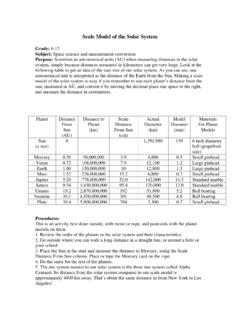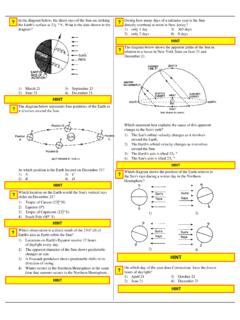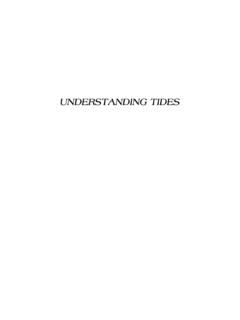Transcription of THE EARTH IN THE SOLAR SYSTEM
1 THE EARTH IN THE SOLAR SYSTEMHow wonderful it is to watch the sky after sunset! Onewould first notice one or two bright dots shining inthe sky. Soon you would see the number cannot count them any more. The whole sky isfilled with tiny shining objects some are bright, othersdim. It seems as if the sky is studded with all appear to be twinkling. But if you look atthem carefully you will notice that some of them donot twinkle as others do. They simply glow withoutany flicker just as the moon with these bright objects, you may also seethe moon on most of the days. It may, however, appearat different times, in different shapes and at differentpositions. You can see the full moon only once in abouta month s time. It is Full moon night or Poornima. Afortnight later, you cannot see it at all. It is a Newmoon night or Amavasya. On this day, you can watchthe night sky best, provided it is a clear you wonder why can t we see the moon and allthose bright tiny objects during day time?
2 It is becausethe very bright light of the sun does not allow us to seeall these bright objects of the night sun, the moon and all those objects shining inthe night sky are called celestial celestial bodies are very big and hot. Theyare made up of gases. They have their own heat andlight, which they emit in large amounts. These celestialbodies are called stars. the sun is a twinkling stars in the night sky aresimilar to the sun . But we do not feel their heat orlight, and they look so tiny because they are very very farfrom s DoYou ll need : 1 torch,1 sheet of plainpaper, pencil and :1. Place the torch in the centreof the paper with its glassfront touching the Now draw a circle aroundthe Perforate the paper with theneedle within the Now place the perforatedcircle part of the paper onthe glass front and wrap thepaper around the torchwith a rubber Take care that the switchof the torch is not In a dark room, stand atsome distance facing aplain wall.
3 Switch off allother lights. Now flash thetorch light on the wall. Youwill see numerous dots oflight on the wall, like starsshine in the Switch on all the lights inthe room. All dots of lightwill be almost You may now compare thesituation with what happensto the bright objects of thenight sky after the sun risesin the EARTH : OUR HABITATF igure : Saptarishi and theNorth StarYou must have noticed that allobjects look smaller when seen from adistance. How small an aeroplane lookswhen it is flying at a great height!While watching the night sky, youmay notice various patterns formed bydifferent groups of stars. These arecalled constellations. Ursa Major orBig Bear is one such constellation. Oneof the most easily recognisableconstellation is the small bear orSaptarishi (Sapta-seven, rishi-sages). Itis a group of seven stars (Figure )that forms a part of the large Ursa MajorConstellation.
4 Ask someone elder inyour family or neighbourhood to showyou more stars, planets andconstellations in the ancient times, people used todetermine directions during the nightwith the help of stars. The North starindicates the north direction. It is alsocalled the Pole Star. It always remainsin the same position in the sky. We canlocate the position of the Pole Star withthe help of the Saptarishi. Look at Figure Youwill notice that, if an imaginary line is drawn joiningthe pointer stars and extended further, it will point tothe Pole celestial bodies do not have their own heatand light. They are lit by the light of the stars. Suchbodies are called planets. The word planet comes fromthe Greek word Planetai which means wanderers .The EARTH on which we live is a planet. It gets all itsheat and light from the sun , which is our nearest we look at the EARTH from a great distance, say themoon, it will appear to be shining just as the moon that we see in the sky is a satellite.
5 It is acompanion of our EARTH and moves round it. Like ourearth, there are eight other planets that get heat andlight from the sun . Some of them have their moons SOLAR SYSTEMThe sun, eight planets, satellites and some othercelestial bodies known as asteroids and meteoroidsInteresting FactJupiter, Saturn andUranus have ringsaround them. Theseare belts of small rings may beseen from the earthwith the help of EARTH IN THE SOLAR SYSTEM1. MERCURY- One orbit around sun - 88 days,One spin on axis - 59 VENUS- One orbit around sun - 255 spin on axis - 243 days3. EARTH - One orbit around sun - 365 spin on axis - 1 dayNumber of moons - 14. MARS- One orbit around sun - 687 daysOne spin on axis - 1 day,number of moons - 025. JUPITER- One orbit around sun - 11 years, 11months about 12 years. One spin onaxis - 9 hours, 56 minutes, number ofmoons - 166. SATURN- One orbit around sun - 29 years, 5months.
6 One spin on axis - 10 hours 40minutes, number of moons - about URANUS- One orbit around sun - 84 years. Onespin around axis - 17 hours 14 minutes,number of moons - about NEPTUNE- One orbit around sun - 164 spin on axis-16 hours 7minutes, number of moons - planets - very close to the sun . They are made upof Planets - Very-very far from the sun and are huge planets made up of gases and : The SOLAR System2-9-20144 THE EARTH : OUR HABITAT form the SOLAR SYSTEM . We often call it a SOLAR family,with the sun as its SunThe sun is in the centre of the SOLAR SYSTEM . It is hugeand made up of extremely hot gases. It provides thepulling force that binds the SOLAR SYSTEM . the sun isthe ultimate source of heat and light for the solarsystem. But that tremendous heat is not felt so muchby us because despite being our nearest star, it is faraway from us. the sun is about 150 million km awayfrom the are eight planets in our SOLAR SYSTEM .
7 In order oftheir distance from the sun , they are: Mercury,Venus, EARTH , Mars, Jupiter, Saturn, Uranus easy way to memorise the name of the planets inorder of their distance from the sun is:MY VERY EFFICIENT MOTHER JUST SERVED US the eight planets of the SOLAR SYSTEM movearound the sun in fixed paths. These paths areelongated. They are called orbits. Mercury is nearestto the sun . It takes only about 88 days to completeone round along its orbit. Venus is considered as EARTH s-twin because its size and shape are very muchsimilar to that of the recently (August 2006), Pluto was alsoconsidered a planet. However, in a meeting of theInternational Astronomical Union, a decision wastaken that Pluto like other celestial objects (Ceres, 2003UB313) discovered in recent past may be called dwarf planets. The EarthThe EARTH is the third nearest planet to the sun .
8 Insize, it is the fifth largest planet. It is slightly flattenedat the poles. That is why, its shape is described as aGeoid. Geoid means an EARTH -like you know?Humans havealways beenfascinated gazingat the night sky. Those whostudy the celestial bodiesand their movements arecalled was a famousastronomer of ancientIndia. Today, astronomersall over the world are busyexploring the OriginMany words usedin a language mayhave been takenfrom some other langua , for example, isan English word. It has itsorigin in Greek, whichrelates to the descriptionof the EARTH . It is made oftwo Greek words, ge meaning EARTH and graphia meaning writing .Find out more about you know? Sol in Romanmythology isthe Sungod . SOLAR means related to the sun . Thefamily of the sun is,therefore, called the solarsystem. Write down asmany words using the wordsolar on your own as EARTH IN THE SOLAR SYSTEMC onditions favourable to support life are probablyfound only on the EARTH .
9 The EARTH is neither too hotnor too cold. It has water and air, which are veryessential for our survival. The air has life-supportinggases like oxygen. Because of these reasons, the earthis a unique planet in the SOLAR the outer space, the EARTH appears bluebecause its two-thirds surface is covered by water. Itis, therefore, called a blue MoonOur EARTH has only onesatellite, that is, themoon. Its diametre isonly one-quarter that ofthe EARTH . It appears sobig because it is nearer toour planet than othercelestial bodies. It isabout 3,84,400 km awayfrom us. Now you cancompare the distance ofthe EARTH from the sunand that from the moon moves around the EARTH in about 27 takes exactly the same time to complete one spin. Asa result, only one side of the moon is visible to us onthe moon does not have conditions favourable forlife. It has neither water nor air. It has mountains,What do animals andplants require in orderto grow and survive?
10 Figure : The moon as seen fromthe spaceDo you know?Light travels atthe speed ofabout 300,000km per , even with this speed,the light of the sun takesabout eight minutes toreach the FactNeil Armstrong wasthe first man tostep on the surfaceof the moon on 21 July1969. Find out whetherany Indian has landed onthe moon ?A Satellite is a celestialbody that moves aroundthe planets in the sameway as the planets movearound the Human-made Satelliteis an artificial body. It isdesigned by scientists togather information aboutthe universe or forcommunication. It iscarried by a rocket andplaced in the orbit aroundthe of the Indiansatellites in space are INSAT,IRS, EDUSAT, : Human-made SatelliteRocket launchRocket falls back to the EarthSatellite enters orbit??2-9-20146 THE EARTH : OUR HABITAT plains and depressions on its surface.














